Transcriptional dynamics and epigenetic regulation of E and ID protein encoding genes during human T cell development
- PMID: 35967340
- PMCID: PMC9366357
- DOI: 10.3389/fimmu.2022.960918
Transcriptional dynamics and epigenetic regulation of E and ID protein encoding genes during human T cell development
Abstract
T cells are generated from hematopoietic stem cells through a highly organized developmental process, in which stage-specific molecular events drive maturation towards αβ and γδ T cells. Although many of the mechanisms that control αβ- and γδ-lineage differentiation are shared between human and mouse, important differences have also been observed. Here, we studied the regulatory dynamics of the E and ID protein encoding genes during pediatric human T cell development by evaluating changes in chromatin accessibility, histone modifications and bulk and single cell gene expression. We profiled patterns of ID/E protein activity and identified up- and downstream regulators and targets, respectively. In addition, we compared transcription of E and ID protein encoding genes in human versus mouse to predict both shared and unique activities in these species, and in prenatal versus pediatric human T cell differentiation to identify regulatory changes during development. This analysis showed a putative involvement of TCF3/E2A in the development of γδ T cells. In contrast, in αβ T cell precursors a pivotal pre-TCR-driven population with high ID gene expression and low predicted E protein activity was identified. Finally, in prenatal but not postnatal thymocytes, high HEB/TCF12 levels were found to counteract high ID levels to sustain thymic development. In summary, we uncovered novel insights in the regulation of E and ID proteins on a cross-species and cross-developmental level.
Keywords: E proteins; ID proteins; T cell development; epigenetics; gene regulation; gene regulatory networks; human; thymocytes.
Copyright © 2022 Roels, Van Hulle, Lavaert, Kuchmiy, Strubbe, Putteman, Vandekerckhove, Leclercq, Van Nieuwerburgh, Boehme and Taghon.
Conflict of interest statement
The authors declare that the research was conducted in the absence of any commercial or financial relationships that could be construed as a potential conflict of interest.
Figures

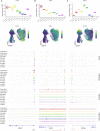
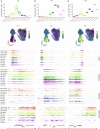


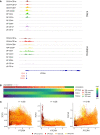

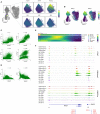

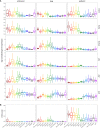
Similar articles
-
An early decrease in Notch activation is required for human TCR-alphabeta lineage differentiation at the expense of TCR-gammadelta T cells.Blood. 2009 Mar 26;113(13):2988-98. doi: 10.1182/blood-2008-06-164871. Epub 2008 Dec 3. Blood. 2009. PMID: 19056690
-
Premature expression of T cell receptor (TCR)alphabeta suppresses TCRgammadelta gene rearrangement but permits development of gammadelta lineage T cells.J Exp Med. 2000 Aug 21;192(4):537-48. doi: 10.1084/jem.192.4.537. J Exp Med. 2000. PMID: 10952723 Free PMC article.
-
Human alpha beta and gamma delta thymocyte development: TCR gene rearrangements, intracellular TCR beta expression, and gamma delta developmental potential--differences between men and mice.J Immunol. 2006 Feb 1;176(3):1543-52. doi: 10.4049/jimmunol.176.3.1543. J Immunol. 2006. PMID: 16424183 Free PMC article.
-
Direct regulation of TCR rearrangement and expression by E proteins during early T cell development.WIREs Mech Dis. 2022 Nov;14(6):e1578. doi: 10.1002/wsbm.1578. Epub 2022 Jul 18. WIREs Mech Dis. 2022. PMID: 35848146 Free PMC article. Review.
-
At the crossroads: diverse roles of early thymocyte transcriptional regulators.Immunol Rev. 2006 Feb;209:191-211. doi: 10.1111/j.0105-2896.2006.00352.x. Immunol Rev. 2006. PMID: 16448544 Review.
Cited by
-
<i>HES6</i>knockdown in human hematopoietic precursor cells reduces their <i>in vivo</i> engraftment potential and their capacity to differentiate into erythroid cells, B cells, T cells and plasmacytoid dendritic cells.Haematologica. 2024 Nov 1;109(11):3578-3592. doi: 10.3324/haematol.2023.283432. Haematologica. 2024. PMID: 38572564 Free PMC article.
-
WNT signaling in human pluripotent stem cells promotes HDAC2-dependent epigenetic programs and development of retinoic acid-responsive mesoderm.bioRxiv [Preprint]. 2025 Jun 8:2025.06.06.657928. doi: 10.1101/2025.06.06.657928. bioRxiv. 2025. PMID: 40661576 Free PMC article. Preprint.
-
γδ T cells: origin and fate, subsets, diseases and immunotherapy.Signal Transduct Target Ther. 2023 Nov 22;8(1):434. doi: 10.1038/s41392-023-01653-8. Signal Transduct Target Ther. 2023. PMID: 37989744 Free PMC article. Review.
-
Human NCR3 gene variants rs2736191 and rs11575837 alter longitudinal risk for development of pediatric malaria episodes and severe malarial anemia.BMC Genomics. 2023 Sep 13;24(1):542. doi: 10.1186/s12864-023-09565-1. BMC Genomics. 2023. PMID: 37704951 Free PMC article.
-
Genome-wide CRISPR screen identifies IRF1 and TFAP4 as transcriptional regulators of Galectin-9 in T cell acute lymphoblastic leukemia.Sci Adv. 2025 Mar 21;11(12):eads8351. doi: 10.1126/sciadv.ads8351. Epub 2025 Mar 19. Sci Adv. 2025. PMID: 40106574 Free PMC article.
References
Publication types
MeSH terms
Substances
LinkOut - more resources
Full Text Sources
Molecular Biology Databases

